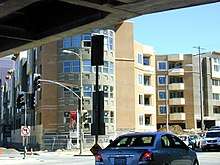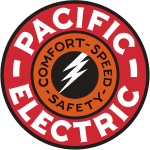Belmont Tunnel/Toluca Substation and Yard
The Belmont Tunnel (or Hollywood Subway) / Toluca Substation and Yard is a designated historic monument located within the city limits of Los Angeles, remnants of the former Pacific Electric Railway's line that ran between the Subway Terminal Building in Downtown Los Angeles and the residential district of Westlake. The monument occupies a property roughly one mile (1.6 km) west of downtown.
| Belmont Tunnel / Toluca Substation and Yard | |
|---|---|
The remaining tunnel portal in 2017 | |
| Coordinates | 34°3′36.56″N 118°15′32.8″W |
| Designated | February 23, 2005 |
| Reference no. | 790 |
Location
The monument is adjacent to 299 South Toluca Street, in Westlake. It is bounded by 2nd Street and the Beverly Boulevard viaduct to the north, Lucas Avenue to the west, Emerald Street to the south, and Toluca Street to the east.
History
1920s – 1950s
Although the monument is regarded by many Angelenos as another example of urban decay, it has a rich history dating back to the early 1920s. Responding to the traffic congestion that clogged the streets of downtown, the California Railroad Commission in 1922 issued Order 9928, which commissioned the Pacific Electric company to construct a subway to bypass downtown's busy streets.[1] Plans for the proposed "Hollywood Subway" were drafted as early as February 1924, and ground was broken in May of the same year.[1]
After 18 months of construction and $1.25 million in expenditures, the subway officially opened to the public on December 1, 1925.[1] Traveling a distance of slightly over one mile, the subway connected the intersection of Beverly and Glendale Blvds in Westlake with the Subway Terminal Building at the corner of Fourth and Hill Streets in downtown. The subway cars were powered by a new substation - Toluca No. 51 - which was constructed in the yard adjacent to the tunnel portal.
The subway proved to be a successful operation and quickly emerged as one of Los Angeles' most popular means of transit. As a faster and more convenient alternative to the streetcar or the automobile, it transported thousands of commuting Angelenos each day through the 1920s and 1930s. Ridership hit its peak during the Second World War; in 1944 - considered to have been the peak of the subway's operation - an estimated 65,000 passengers traversed the Belmont Tunnel on a daily basis.[2]
The construction of an extensive freeway system throughout Southern California ultimately led to the closure of the subway in the 1950s. As Angelenos became increasingly reliant on the personal automobile, ridership plummeted and forced the struggling Pacific Electric company to abandon their operation in 1955. The last subway car to carry passengers - carrying a banner reading "To Oblivion" - traversed the subway on the morning of June 19, 1955.[2] Shortly thereafter, Pacific Electric removed the tracks from the subway, closed the Subway Terminal Building and Toluca Substation, and left the site abandoned.
1960s – present
Few changes have been made to the subway, substation and yard since closure, as the site of the former railway has long escaped the attention of city officials. In the 1960s, the city briefly attempted to make use of the subway for the storage of impounded automobiles, and later as a makeshift disaster shelter.[1] The only physical alteration to the site came about in 1967, when a portion between Flower and Figueroa Streets in downtown was filled in to accommodate the foundation of the Bonaventure Hotel.

Over the next 35 years, the site was left largely neglected and its historical significance was overshadowed by its gritty, run-down appearance. The abandoned subway, substation and yard, left intact and open to public view, attracted many graffiti artists.[1] The site also appealed to the homeless, who took refuge in the shelter provided by the subway and substation. There were also several underground "rave" parties in the 1990s, often with the power being supplied from one of the neighboring residential dwellings. To locals and passers-by, the site - simply referred to as "The Tunnel" - has long blended into the landscape and is regarded as little more than another vacant lot.
Current use
In 2002, West Los Angeles-based Meta Housing Corporation purchased the property and announced plans to construct a 276-unit apartment complex on the former Toluca yard. Belmont Station Apartments was completed in late 2008. The entrance to the subway has been sealed and painted with a mural of a Red Car, which glows in the dark, by artist Tait Roelofs.[3] The substation remains next to the subway entrance at the back of the property, behind the new construction, and has been cleaned of the graffiti that adorned it for many decades.
Media location
The tunnel and the substation have been used in a large number of TV shows and movies and other creative genres:
- The substation was used as the Resistance headquarters in the TV 1980's miniseries V.
- The tunnel is the entrance from the refugee camp in the 1987 film The Running Man.
- The substation is used as a gang clubhouse in the 1988 film Colors.
- The spacecraft used by the Predator in 1990 film Predator 2 was hidden in the tunnel.
- The substation is used in 1992 film Reservoir Dogs as the location for Freddy Newandyke to prepare to go undercover as Mr. Orange.
- The substation appears as an underground nightclub in the 2004 movie D.E.B.S..
- The cover art for the album Take Them On, On Your Own by Black Rebel Motorcycle Club was taken in inside the tunnel.
- The station appears in the video for "Under The Bridge" and the interior of the tunnel in the video for By The Way by the Red Hot Chili Peppers.
- The substation is seen briefly in the music video for "Get U Down Pt. 2" by Warren G.
- The tunnel and substation is featured in the 2005 skateboarding video game Tony Hawk's American Wasteland, in which the player uses the tunnel to travel to from Downtown LA to East LA.
- The 2011 neo-noir detective video game L.A. Noire - set in 1947 - recreates the tunnel and substation in full use.
See also
- Pacific Electric Railway
- Subway Terminal Building
References
- "Pacific Electric Hollywood Subway". Electric Railway Historical Association of Southern California.
- "Pacific Electric Subway Terminal". Electric Railway Historical Association of Southern California.
- Harvey, Steve (February 8, 2009). "The colorful saga of Los Angeles' first subway tunnel". Los Angeles Times.
External links
- Wikimapia, Pacific Electric Belmont Tunnel Portal, with historic photographs
- Documentary on the Belmont Tunnel focusing on its history as a railroad depot, as a graffiti yard, and as a field where community residents played the Tarasca game
- Howser, Huell (November 17, 2008). "Subway Terminal Update". Visiting...With Huell Howser. Season 16. Episode 17. KCET. A 2008 public television documentary about the history of the Subway Terminal Building and the Belmont Tunnel.
